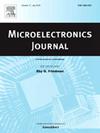低功耗、低相位噪声、宽频率范围 PLL
IF 1.9
3区 工程技术
Q3 ENGINEERING, ELECTRICAL & ELECTRONIC
引用次数: 0
摘要
本文介绍了一种用于 WLAN/WiFi 收发器的低噪声、低功耗、宽输出频率范围锁相环 (PLL)。通过采用双对称 CMOS 交叉耦合对差分电感压控振荡器 (VCO),该设计实现了低相位噪声。此外,改进型相位频率检测器(PFD)和具有反馈补偿偏置控制功能的可编程低失配电荷泵(CP)可用于缓解不同参考频率引起的带宽和噪声变化。改进型电荷泵 PLL (CPPLL) 采用 65 纳米 CMOS 工艺设计,芯片布局占地面积为 0.28 平方毫米。布局后仿真结果表明,该 PLL 的调谐范围为 4.6 GHz 至 6 GHz,5 GHz 时偏移 1 MHz 的相位噪声为 111.7 dBc/Hz,总功耗为 7.14 mW,锁定时间约为 9μs。本文章由计算机程序翻译,如有差异,请以英文原文为准。
A low power low phase noise wide frequency range PLL
This paper presents a low-noise, low-power, wide output frequency range phase-locked loop (PLL) for WLAN/WiFi transceivers. By employing a dual-symmetric CMOS cross-coupled pair differential inductor voltage-controlled oscillator (VCO), the design achieves low phase noise. In addition, an improved phase frequency detector (PFD) and a programmable low-mismatch charge pump (CP) with feedback compensation bias control are used to mitigate bandwidth and noise variations caused by different reference frequencies. The improved charge pump PLL (CPPLL) is designed in 65 nm CMOS process, and the chip layout occupies an area of 0.28 mm. Post-layout simulation results indicate that the PLL has a tuning range of 4.6 GHz to 6 GHz, a phase noise of 111.7 dBc/Hz at 1 MHz offset at 5 GHz, a total power consumption of 7.14 mW, and a lock time of about .
求助全文
通过发布文献求助,成功后即可免费获取论文全文。
去求助
来源期刊

Microelectronics Journal
工程技术-工程:电子与电气
CiteScore
4.00
自引率
27.30%
发文量
222
审稿时长
43 days
期刊介绍:
Published since 1969, the Microelectronics Journal is an international forum for the dissemination of research and applications of microelectronic systems, circuits, and emerging technologies. Papers published in the Microelectronics Journal have undergone peer review to ensure originality, relevance, and timeliness. The journal thus provides a worldwide, regular, and comprehensive update on microelectronic circuits and systems.
The Microelectronics Journal invites papers describing significant research and applications in all of the areas listed below. Comprehensive review/survey papers covering recent developments will also be considered. The Microelectronics Journal covers circuits and systems. This topic includes but is not limited to: Analog, digital, mixed, and RF circuits and related design methodologies; Logic, architectural, and system level synthesis; Testing, design for testability, built-in self-test; Area, power, and thermal analysis and design; Mixed-domain simulation and design; Embedded systems; Non-von Neumann computing and related technologies and circuits; Design and test of high complexity systems integration; SoC, NoC, SIP, and NIP design and test; 3-D integration design and analysis; Emerging device technologies and circuits, such as FinFETs, SETs, spintronics, SFQ, MTJ, etc.
Application aspects such as signal and image processing including circuits for cryptography, sensors, and actuators including sensor networks, reliability and quality issues, and economic models are also welcome.
 求助内容:
求助内容: 应助结果提醒方式:
应助结果提醒方式:


